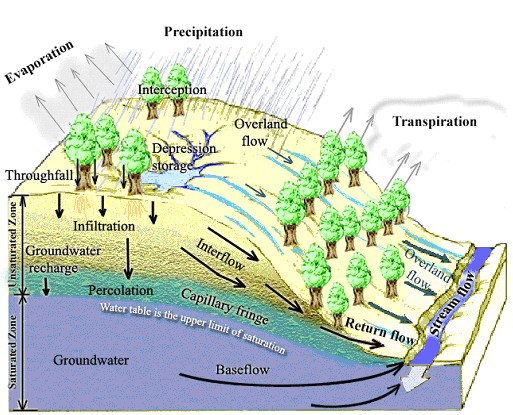Runoff Processes
Where does water go when it rains? Figure 1 shows the pathways followed by water following “surface water input” which is used as a general term preference to rainfall to be inclusive of snowmelt. Quantifying this amount of streamflow due to surface water input is important for addressing flooding and other water resources management problems.

Figure 1. Physical Processes involved in Runoff Generation.
Vegetation may intercept some fraction of precipitation.Precipitation that penetrates the vegetation is referred to as throughfall.Much intercepted water is evaporated back to the atmosphere.There is also flux of water to the atmosphere through transpiration of the vegetation and evaporation from soil and water bodies.Surface water input may accumulate on the surface in depression storage, or flow overland towards the streams as overland flow, or infiltrate into the soil, where it may flow laterally towards the stream contributing to interflow.Infiltrated water may also percolate through deeper soil and rock layers into the groundwater.The water table is the surface below which the soil and rock is saturated and at pressure greater than atmospheric.This serves as the boundary between the saturated zone containing groundwater and unsaturated zone.Water added to the groundwater is referred to as groundwater recharge.The capillary fringe is a region immediately above the water table that is close to saturation, due to water being held by capillary forces.Lateral baseflow from the groundwater into streams sustains streamflow during rainless periods. Return flow is subsurface water that flows back across the land surface to add to overland flow. Overland flow and shallower interflow processes that transport water to the stream within the time scale of approximately a day or so are classified as runoff. Water that percolates to the groundwater moves at much lower velocities and reaches the stream over longer periods of time such as weeks, months or even years. The terms quick flow and delayed flow are also used to describe and distinguish between runoff and baseflow. Runoff includes surface runoff (overland flow) and subsurface runoff or subsurface stormflow (interflow).


